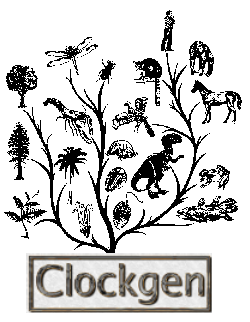
|
| Molecular Clock Simulator |

|
| Molecular Clock Simulator |
home · download · quickstart · references · index
Clockgen has been developed with the objective of creating a database of nucleotide sequences that evolve in a clock-like fashion, so we can use these sequences to simulate complete phylogenies and compare them with the ones obtained with real life data. For that reason it's output is in the FASTA format (which can be read by almost all phylogenetic softwares).
Following the model of evolution, and the parameters described below, clockgen creates a full phylogeny from a first (ancestral) sequence which may be randomly generated or not. Each run of the program generates a valid FASTA file with all the sequences generated. The output is written to the standard output, which can be easily redirected to any filename you might wish.
Clockgen has the flexibility of reading in any Model of Evolution derived from the General Reversible Model. The software package provides most of the commonly used (and computationaly tractable) models of DNA evolution. The simple file format for the Model input is described below.
All models of nucleotide substitution compatible with Clockgen are Markov models, and assume evolution is independent and indentical at each site and along each lineage. Almost all models used in the maximum likelihood reconstruction of phylogenies using nucleotide sequences are processes of this type (but see Yang, 1994).
The models are provided in the matrix form:
| General Reversible | Jukes-Cantor | Kimura 2 Parameters | |||||||||||||||||||||||||||||||||||||||||||||||||||||||||||||||||||||||||||
|
|
|
Where each variable is the rate of substitution between the nucleotide in the row and the nucleotide in the column. All rows must sum 1.0.
The General Reversible model has 6 variables that work like this, and thus can. be manipulated in order to represente any given reversible model. But the Kimura 2 Parameters has only two variables (x and y), that represent transversions_rate transitions rate respectively. These values must be assigned according to the following formula so that the "All rows must sum 1.0" rule stands:
Transmission bottleneck may be simulated with clockgen by making use of the parameter "-i" which allows you to provide a sequence as the Ancestral for simulation, and "-hi" making different hosts for each simulation.
Basically you should run a complete simulation, then open the output file and select the sequence you want to simulate the transmission. Copy and paste it into a new file, alone, and give it as input for a new simulation. Now you'll have two evolutionary trees, that evolved independantly in different environments after the transmission. This can be repeated as many times as you need.
| Model Name | Model | Parameters (All parameters are decimal numbers) |
|---|---|---|
| Juckes-Cantor | JC | No parameters |
| Kimura 2 Parameters | K2P | transitions_rate transversions_rate |
| General Reversible | REV | AC AG AT CG CT GT |
Be aware of the rules of an evolutionary model matrix before using specific parameters.
If no name is provided, a default name of Taxon is used.
home · download · quickstart · references · index